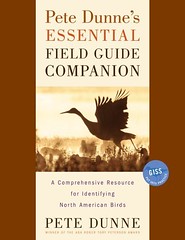 After paging through a typical field guide to the birds of North America, most people become intimidated by the many hundreds of bird species that are pictured. When one considers the myriad different plumages for juvenile, immature and adult birds, males versus females, and seasonal plumage differences, the possibilities increase into the thousands. Suddenly, a pleasant and relaxing morning spent identifying a few birds becomes stressful, daunting, impossible. In fact, faced with such a task, it is easier to give up before even getting started. This is where Pete Dunne's Essential Field Guide Companion: A Comprehensive Resource for Identifying North American Birds (NYC: Houghton Mifflin, 2006) can help.
After paging through a typical field guide to the birds of North America, most people become intimidated by the many hundreds of bird species that are pictured. When one considers the myriad different plumages for juvenile, immature and adult birds, males versus females, and seasonal plumage differences, the possibilities increase into the thousands. Suddenly, a pleasant and relaxing morning spent identifying a few birds becomes stressful, daunting, impossible. In fact, faced with such a task, it is easier to give up before even getting started. This is where Pete Dunne's Essential Field Guide Companion: A Comprehensive Resource for Identifying North American Birds (NYC: Houghton Mifflin, 2006) can help.
As the long-time director of the Cape May Bird Observatory and guru for the unofficial "Cape May School of Birding", Pete Dunne teaches a holistic, or "broad brush" approach to bird identification instead of relying on seeing small and easily missed details of plumage and other markings. This approach to bird identification is based on the bird's GISS (pronounced "jizz"), or General Impression of Size and Shape. In addition to the observer's impression of the bird's shape and size, GISS also relies on general features, such season and geographic location along with characteristics such as the bird's flight profile and style, in addition to specifics for each species, such as song, call notes, plumage color patterns and, especially, behavioral traits and habitat preferences. Despite its utility, it is unrealistic for everyone to expect to learn this approach directly from the master. however, almost as if to answer this long-standing need in the birding community, Dunne has finally documented his methodology and philosophy into one very large book for the benefit of all the rest of us.
This massive volume, comprised of 710 pages, was never intended to be hauled into the field (although you might want to leave it in your car as a handy reference), nor can it replace your comparatively small and light field guide with its pictures of birds and pithy identification notes. Instead, this book is a descriptive reference whose pages are filled with small text, detailing each species' unique GISS, with nary a picture or diagram to be found. Inside these pages, you will find profiles for 691 species and subspecies of birds that live or breed in, migrate through or, regularly show up north of the Mexican-American border. Yet, even though this is a reference, the author's personable writing style transforms a complicated and potentially intimidating topic into one that is accessible and interesting and fun.
Like all good reference works, this tome begins with an introduction where the author describes his main premise for writing this book, followed by a "guide to the guide" that describes, among other things, how to make this book work for you, and in the back of the book, there is an extensive index. A new feature for this book is its organization of bird species follows the modern phylogenetic arrangement as revealed by DNA sequence evidence instead of traditional taxonomic rankings. So, for example, the book begins with the waterfowl and gamebirds, instead of the loons, and it includes the vultures with the storks and flamingos instead of placing them next to the raptors. Introduced species, such as house sparrows, are still listed at the end of the book.
The true value of this book is found in its species accounts. Each species account begins with the bird's common and scientific names, followed by a unique nickname that the author uses to capture the most relevant features of that bird with a few words or a phrase. These appellations are informative, amusing or appropriately descriptive, such as lawn plover (American Robin), Bronx petrel (rock pigeon, often referred to as the "sky rat"), the sidewalk sparrow (the introduced house sparrow) and the everywhere finch (house finch). Each species profile is comprised of categories containing contextual information about the species' Status, Distribution, Habitat, Cohabitants, and Movement/Migration, followed by Description, Behavior, Flight, and Vocalizations, which add a more specific impression for each species. Often, following these categories is another called Pertinent Particulars. This is a special section for information that doesn't neatly fit into the other categories; this category sometimes summarizes key points, sometimes compares similar species, and sometimes offers titbits related to finding or identifying the bird.
Whether you are a beginner or a life-long birder, this valuable resource will impart a deeper and richer understanding of birds and will tremendously improve your overall birding experience. I highly recommend Pete Dunne's Essential Field Guide Companion for yourself or for the bird lover in your life.
Pete Dunne is the author of ten books, including Hawks in Flight (one of my personal favorites), Pete Dunne on Bird Watching, and The Wind Masters. Dunne is the vice president of the New Jersey Audubon Society and the director of the Cape May Bird Observatory. He has written columns and articles for virtually every birding magazine known to humanity in addition to some pieces that appeared in the New York Times.
- Log in to post comments
